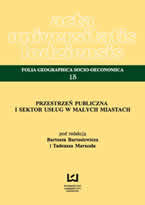MAŁE MIASTA W DUŻYCH, DUŻE MIASTA W MAŁYCH-WSPÓLNOTY LOKALNE CZY ALIENACJA W PRZESTRZENI PUBLICZNEJ
SMALL CITIES WITHIN BIG ONES, BIG CITIES WITHIN SMALL ONES - LOCAL COMMUNITIES OR ALIENATION IN THE PUBLIC SPHERE
Author(s): Adam GórkaSubject(s): Essay|Book Review |Scientific Life
Published by: Wydawnictwo Uniwersytetu Łódzkiego
Keywords: small towns; public space
Summary/Abstract: What distinguishes a small city from a big one? Is it merely the number of inhabitants? Or is it the presence of a particular range of functions according to Christaller’s Central Place Theory? Apart from these factors, urban space, and especially public space, plays a significant role in how a city is perceived, as evidenced by the frequent usage in descriptions of cities of adjectives such as: “metropolitan”, “small-town”, and “provincial”. Contemporary theories aimed at describing the developmental processes taking place within cities (e.g. the concept of the postmodern city) point to the increasing mobility of city dwellers, which results in alienation and a loosening of local bonds. This is generally the way big cities (or postmetropolises) are described, whereas small cities are generally perceived as “havens of the familiar”, mainly due to their traditional social structures, epitomized by the local community. It turns out, however, that local communities have survived in big cities, while small cities are undergoing a process of alienation. Both small and big cities are witnessing a rise in gated housing developments, surveillance cameras, and replacement of the public sphere with a quasi - public sphere. At the same time, in many places, traditional social structures have been preserved; in them, the public sphere is treated as if it belonged to the community, and social control, rather than surveillance cameras, plays a dominant role. Interestingly, processes very similar to those found in small cities can also be observed in bigger cities, where the community with which citizens identify is not the city as a whole, but rather a particular district. These phenomena are related to specific types of public space and processes that are characteristic of them. In this study, I will discuss these processes in the context of public space. Theoretical reflections will be supported by research and observations conducted in recent years in both big and small cities in the Małopolska region.
Journal: Acta Universitatis Lodziensis. Folia Geographica Socio-Oeconomica
- Issue Year: 15/2013
- Issue No: 3
- Page Range: 293-304
- Page Count: 12
- Language: Polish

